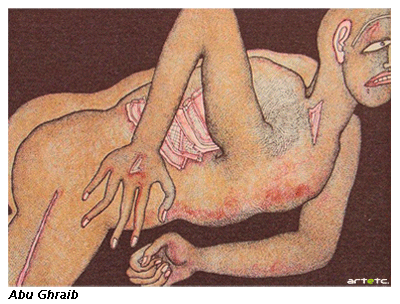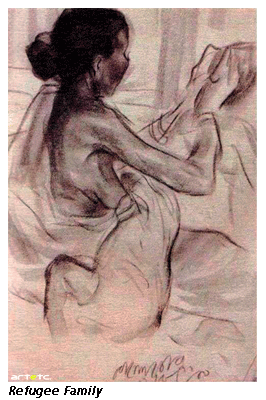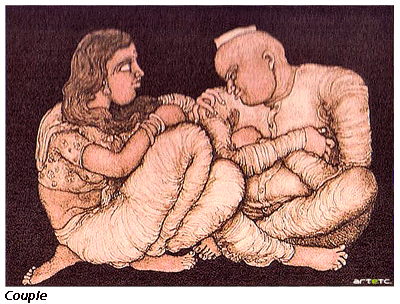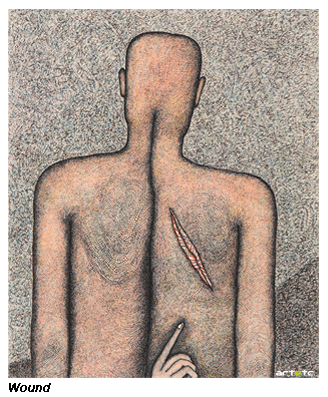- Publisher's Note
- Editorial
- Jogen Chowdhury: Maestro par Excellence
- Company School Paintings of Calcutta, Murshidabad, Patna (1750-1850): Doctoral Thesis of Late Dipak Bhattacharya (1960-2007)
- Kalighat Pat, a Protomodern Art Tradition?
- Academic Naturalism in Art of Bengal: The First Phase of Modernity
- Under the Banyan Tree - The Woodcut Prints of 19th Century Calcutta
- The Arabian Nights and the Web of Stories
- Gaganendranath Tagore's Satirical Drawings and Caricatures
- Gaganendranath's Moments with Cubism: Anxiety of Influence
- Abanindranath as Teacher: Many Moods, Some Recollections
- Atul Bose: A Short Evaluation
- J.P. Gangooly: Landscapes on Canvas
- Defined by Absence: Hemen Majumdar's Women
- Indra Dugar: A Profile of a Painter
- The Discreet Charm of Fluid Lines!
- Delightful Dots and Dazzling Environments: Kusama's Obsessive Neurosis
- Peaceful be Your Return O Lovely Bird, from Warm Lands Back to My Window
- Shunya: A Beginning from a Point of Neutrality
- The Tagore Phenomenon, Revisited
- The Bowl, Flat and Dynamic Architecture of the BMW Museum
- Baccarat Paperweights: Handmade to Perfection
- Byzantium and Islam: Age of Transition at the Metropolitan Museum of Art
- Outstanding Egyptian Art at the Metropolitan Museum of Art
- Retrospective of Wu Guanzhong at the Asia Society Museum
- Masterpieces from India's Late Mughal Period at the Asia Society Museum
- The Dhaka Art Summit: Emergence of Experimental Art Forms
- Many Moods of Eberhard Havekost
- Random Strokes
- Is it Putin or the Whole Russian State?
- The Onus Lies With Young India
- What Happened and What's Forthcoming
- Preview May, 2012 – June, 2012
- In the News, May 2012
- Art Events Kolkata, April – May 2012
- Mumbai Art Sighting
- Delhi Dias
- Art Bengaluru
- Musings from Chennai
- Cover
ART news & views
Jogen Chowdhury: Maestro par Excellence
Issue No: 29 Month: 6 Year: 2012
Jogen Chowdhury in an exclusive interview with Sreyashi Ghosh talks about his oeuvres extraordinaire as always strong, bold, and minimalistic yet his lines speak volumes.

To comment on a huge body of work of five decades is challenging, but Jogen Chowdhury, the genius of lines and master of the intriguing pen and ink strokes accentuating the contours of the human anatomy complemented by his unique style of cross hatches impresses with ease. Jogen Chowdhury's works are socio-political comments making statements in protest. The art historian R. Sivakumar states: “The pulse and rhythm of Jogen Chowdhury's art comes from a filial affinity to nature and milieu.” To a lay viewer, Jogen Chowdhury's art stirs up a strange curiosity. His images leave an indelible impression, lucid yet didactic in its statement. Jogen Chowdhury's bold unbroken lines follow a rhythmic pattern much like poetry which lends a simple yet complex charm to his artworks. Art connoisseurs the world over have a penchant for his cross hatches. Of course Masanori Fukuoka, director Glenbarra Art museum says his cross hatches are “avant garde in flavour”.
Sreyashi Ghosh: What is “protest art” to you?
Jogen Chowdhury: Protest is “protest art” when it is borne out of experiences from an honest/ authentic interest in social issues, not otherwise. If someone is protesting for the sake of protest in order to create a buzz or attract attention then that is not real, it is artificial. However a right protest for a right cause with a mission is important and essential for a socially conscious person.
SG: When does something ceases to be called “art”?
JC: Art in the name of protest gets circulation, but not everything is art. When something is a reaction to the environment or as a result of certain experiences then that pertaining to subject, form, emotion, comment which adheres to these elements in art, then it might be called 'art'. Also the viewer should be able to identify with it. But art has a sublime quality. It is transcendental. It connects to the sense of infinity.
SG: Loss and longing in your works is reflective of your time post-partition when you had to leave your village in Faridpur (now in Bangladesh). Where did you begin your journey as an artist?
JC: We were in a despicable state post partition and had to go through many hardships, this is reflected in my paintings. One incident was when I painted a peacock with red and blue pencil in my uncle's home in Calcutta. This is when I became conscious of the fact that probably I have the talent of becoming an artist.

SG: As a reaction to the Gujarat riots you drew a pregnant woman whose foetus was slit open, called The Unborn Child.
 JC: I feel very strongly about the social injustices in the world happening around me. As a reaction to this horrific event I had to paint it. Abu Ghraib is created out of that reaction. The pen and ink lines make an allegory on the human condition of a prisoner.
JC: I feel very strongly about the social injustices in the world happening around me. As a reaction to this horrific event I had to paint it. Abu Ghraib is created out of that reaction. The pen and ink lines make an allegory on the human condition of a prisoner.
SG: Your approach is sublime rhetoric rather than polemic narratives. Your binary pen and ink have a deep didactic impact on the mind of the viewer. Probably gazing upon the images might take the viewer into deep reflection as poetic expressions. You are also a poet, so how would you say visual art and poetry are connected?
JC: Visual Art and poetry are connected; my first book published was Hridaye Train Bejey Othey, then in 2003 another collection of poems in Bengali was published. I love writing poetry and reading as well. I read Jibananada Das, Joy Goswami, Sakti Chatterjee, Tagore and many others. I also read and write on several subjects. I also observe human beings. In fact the art of painting and the art of poetry both come from the same sensibilities and aesthetic sense of human mind.
A few lines from his poems:
“Strike: The whole city slick with sweat
Lurching. Drunk
Glancing. Oblique
Drawing. A single crooked line
Or
Across the smithereens of the city's face
Two hands. A flag. Fluttering ceaselessly.”
SG: What is your opinion on the different mediums used? When is one's work in the 'modern' or 'post – modern' nomenclature?
JC: Material or medium is secondary, for a creative person, it is essential to have a modern mind to create a modern artwork. Art becomes real only with true conviction. It is how one handles a certain medium and what the artist is trying to express and whether he is being able to do so freely or not. An artwork of post modern art surpasses notions of various elemental characters of “modern art”. However no art can really be valid if it does not contain the fundamental elements of art. Post – modernism has only certain outward characteristics cultivated on the basis of new mediums and culture.
SG: Tell me about your time while studying at Ecole Superiure des Beaux Arts in Paris.
JC: My work has evolved, it has changed over time, though I have always been influenced by my environment, situations around me and motivated by social and political injustices. In Paris, disturbances, restlessness, differences and surprises of the European way of life, inspired me initially to paint.
SG: What is your message to young artists? How do you look at your own images and creations?
JC: What comes from the heart or is an inner calling will be appreciated and recognized but they are based on one's knowledge and experiences of an artist. I wouldn't call them disturbing images, but “beauty” is not what you are looking for when you look at my work but something more profound and sublime as if it “teases us out of thought”.
SG: Later on your days in Government Art College what was your form of expression?
JC: Pen and ink has always been my forte, I did participate in social awareness activities then as well. I used to go to the station to sketch for hours in those days, when we were hungry we would eat beef rolls with 25 paise in New Market, since we had restricted funds and sketched for hours. Even then I felt that the government wasn't doing anything and in that sense going against what was wrong I called myself a leftist, not in a political sense. Only after studying at Government Art College and in the evenings at the studios in academy of fine arts, and not until after 1961, did I develop my search independently.
SG: Any particular issue you are close to?
 JC: An artist cannot comment on all the happenings, but his experiences affect his art and for an artist the social milieu, the surroundings do cause him or her to react and I have just done that. I am updated with current affairs not only on matters of social injustices or politics, but also on technology and the latest happenings in the world through journals. But I have worked on refugees since I felt strongly and was deeply impacted by the partition, then on poverty, human rights violations and Gujarat riots.
JC: An artist cannot comment on all the happenings, but his experiences affect his art and for an artist the social milieu, the surroundings do cause him or her to react and I have just done that. I am updated with current affairs not only on matters of social injustices or politics, but also on technology and the latest happenings in the world through journals. But I have worked on refugees since I felt strongly and was deeply impacted by the partition, then on poverty, human rights violations and Gujarat riots.
SG: What inspired your art work? Which artists influenced you?
JC: I like Picasso. He may have influenced me on my early works. I have seen his exhibitions while in Paris at the Grand Palais, Petit Palais and National Bibliotheque. Then I would say van Gogh, Cezannne, Paul Klee, Giacomelli, Henri Rousseau fascinated me. Ramkinkar Baij is also another artist whose work I admire besides Rabindranath Tagore. In fact I am deeply inspired by Bengal Terracotta, Patachitra or even Kalighat paintings or our “yatra” form of theatre.
SG: What was your experience while working at the Rashtrapati Bhavan?
JC: Rashtrapati Bhavan was a unique experience as well. The role of a curator is different from what we talk of as a curator and curatorial practices as we know it today. Actually it was work of an art keeper and organizing the artworks in the palatial building. From my time the designation of the post changed to Art Keeper at Rashtrapati Bhavan. Of course I met interesting people and mostly it was about politicians, people active in the social scene, I made a series on politicians and one such painting is called The Leader. To depict satire on the corrupt Indian political personality was one of my favourite subjects.
SG: You have donned so many roles. What do you think about diverse experiences and how they contribute to one's work as an artist?
JC: There are so many experiences one has in life and not one is a waste. I have worked as an art teacher in Howrah during my initial days after Government Art College, then in designing textiles with the Handloom board in Calcutta as well as Madras, then working in Rashtrapati Bhavan for 15 years. I really want to write about my experiences and time I spent in the President's house as a Curator and Art Keeper.
SG: M.F. Husain was a significant artist from the Progressive Painters Group. He was a protest artist too and wrote about various social issues. What do you have to say about him being sent on exile? What message does India send out internationally?
JC: I am deeply saddened and disappointed with the fact that artists have no freedom of speech and expression that the so called “moral police” and guardians of art censorship are trying to clamp down creativity and the freedom of an artist. It is sad when an artist cannot work or express his ideas freely. Actually the entire art community supported him and shared their unity for the cause and even the Indian judiciary was with him on their verdict.
SG: Your understanding of the human psyche and portrayal of human condition is noteworthy. Your artworks make powerful social comments. What do you have to say about it?

JC: I am an inquisitive person. I observe people and that is why I have made so many drawings, sketches, doodles etc. in different mediums on people and their lives and have chosen a wide spectrum of subjects with multiple variations in content and form. For example, I have drawn so many different types of couples and over time they have changed and also of so many political personalities.
 SG: Now you have taken up the role of a mentor for many young artists. You had been the former principal of Kala Bhavan in the past. And you along with other professors from Kala Bhavan are also associated with SSVAD, an art centre with an art residency programme for international young artists. How do you see the future of art? What are your projects in the pipeline?
SG: Now you have taken up the role of a mentor for many young artists. You had been the former principal of Kala Bhavan in the past. And you along with other professors from Kala Bhavan are also associated with SSVAD, an art centre with an art residency programme for international young artists. How do you see the future of art? What are your projects in the pipeline?
JC: Education is important. During our times we did not have courses on Art History, certain text materials, books on art were not available to us when we were students, now things are available. With technology we can easily access certain information. But I think we still need to improve our mode of study. The training approach at the art colleges, especially in drawing was extremely academic. We must understand the new developments of art mediums with a sense of creativity related to our own life and environment.
As far as the art market is concerned in Asia, India still has a growing market. India stands at the forefront of art today probably along with China/Japan too. In India with inputs from Delhi and Bombay, Bengal painting has come on its own. Japan is probably far ahead of us in environmentalist sculpture or architecture.
International art has reached a point where at times Western world of art seems to be in a state of destitution with art being made a formal institution like business. I suspect there are these strategies related to media and marketing in the art world “in order to keep the world of art and culture under control.” But even then the experimentation and creativity in Western art are still the moving force in the art world, whereas Eastern and South eastern countries have enormous fresh elements to offer, to enrich the post modern contemporary art movements.